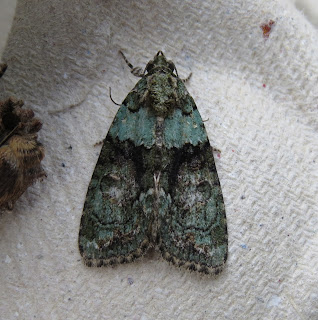A month gone since the longest day and the nights are starting to draw in but with an overnight low of 17.9 Celsius it is a tad warm and still no rain. Single Redshank & Swallow went south and a handful of Common & Sandwich Terns were off the point. A Black Redstart was around the cottage late morning.
This is presumably another example of a Tree-lichen Beauty but of a much different colour scheme to yesterdays example unless anyone knows different. Ground Lackey is a nationally scarce salt marsh specialist that turns up here.
Ringing: 3 House Sparrow, 1 Dunnock.
Friday 20th July 2018
Baby Herring Gulls on the museum roof must be cooking with no cover from the sun.
Half a dozen Sandwich Terns, Redshank & Swallow south are todays migrants.
Tree-lichen Beauty was first noted with great excitement as an immigrant here in 2003 but is now fairly frequent and is part of the scenery. Ypsolopha scrabella is apparently common but it is not here as we only occasionally see it.
Thursday 19th July 2018
The rear of the observatory from the Felixstowe - Harwich foot ferry.
Moving south 21 Black-headed Gull & a Swift with northbound Oyk & Sandwich Tern. Single Black Redstart on the reserve with the two young Kestrels back sitting in the nest box entrance still being fed completes the sightings worth a mention.
Buff-tip occurs in a wide range of habitats and is always pleasing to see. Aphomia zelleri is a Red Data Book species that is very rare nationally but likes all the mosses and Restharrow at Landguard as we record quite a few.
16 birds ringed: 8 Linnet, 5 House Sparrow, 2 Wren, 1 Blackbird.
Wednesday 18th July 2018
Sea Holly pulling in plenty of insects.
On the move southbound 34 Black-headed Gull, 12 Whimbrel, 10 Oyk, 6 Common Tern, 5 Curlew, 3 Cormorant, 3 Common Gull, 3 Swallow, 2 Sandwich Tern & 2 Redshank with northbound 3 Oyk. No obvious grounded migrants on site.
Pebble Prominent is probably on the Poplars & Pyrausta purpuralis on Thymes are both fairly common species that we only see occasionally.
8 birds ringed: 3 House Sparrow, 2 Wren, 1 Dunnock, 1 Linnet, 1 Whitethroat.
Tuesday 17th July 2018
On the move southbound 135 Black-headed Gull, 12 Swallow, 8 Med Gull, 5 Sand Martin, 3 Oyk, 3 Common Tern, 3 Common Gull, 2 Whimbrel & 1 Curlew plus, rather helpfully, on the observatory rough pad someone has written 4 B T Godwit south !
Rhodophaea formosa only visits us on odd occasions so was good to see (although originally thought to be a different species as we forgot it existed). Pima boisduvaliella is a red data book species mostly on Sea Pea.
Ringing: 1 Chaffinch.
Monday 16th July
Bit of a surprise to get a young juvenile Cetti's Warbler considering how low the population is this year in East Anglia following the "beast from the east" back in March which resulted in an almost total wipe-out at many sites. This is only the 8th Landguard record with previous records being in April/May & September/October. Strange that we should get a summer dispersing youngster this year as this phenomena never occurred when populations were higher. Other migrants were southbound 93 Black-headed Gull, 10 Swallow, Curlew & Redshank with northbound 10 Common Scoter plus a Grey Wagtail doing some loitering. Of greater note than the above is Mrs Shelduck with 16 tiny ducklings heading from the reserve out to the sea as, although Shelduck are present on site from March to July, we very rarely prove that they breed successfully.
Species diversity in the moth traps is large at the moment with several species turning up that we only see occasionally including the Drinker & White-spotted Pug. The Drinker likes damp areas so understandably is not here very often whereas the food plants for the pug are on site but its population size is unknown.
17 birds ringed: 5 House Sparrow, 5 Linnet, 4 Whitethroat, 1 Blue Tit, 1 Cetti's Warbler, 1 Goldfinch.
Sunday 15th July 2018
Its getting to look a bit parched out there although the brambles & Elders on the reserve are of a hardy variety.
Always pleasing to get a visitation from a Pale Prominent which lives on Poplars so, in theory, we should see more off them.
19 birds ringed: 8 Linnet, 7 House Sparrow, 2 Wren, 1 Blackcap, 1 Goldfinch.
Subscribe to:
Comments (Atom)



















